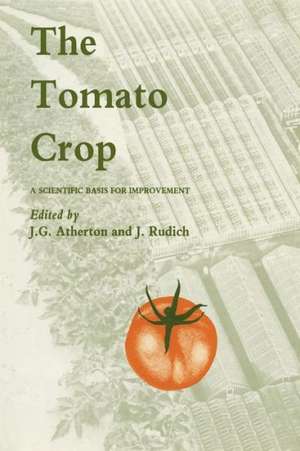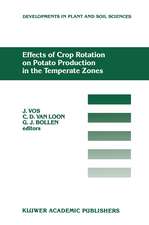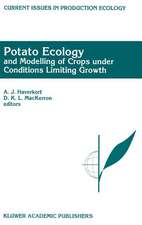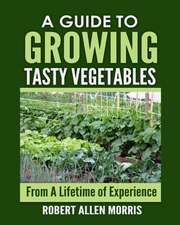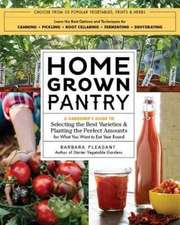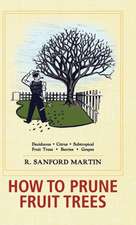The Tomato Crop: A scientific basis for improvement: World Crop Series
Editat de J. Atherton, J. Rudichen Limba Engleză Paperback – 13 noi 2013
| Toate formatele și edițiile | Preț | Express |
|---|---|---|
| Paperback (1) | 1833.78 lei 6-8 săpt. | |
| SPRINGER NETHERLANDS – 13 noi 2013 | 1833.78 lei 6-8 săpt. | |
| Hardback (1) | 1840.43 lei 6-8 săpt. | |
| SPRINGER NETHERLANDS – 31 dec 1986 | 1840.43 lei 6-8 săpt. |
Preț: 1833.78 lei
Preț vechi: 2236.32 lei
-18% Nou
Puncte Express: 2751
Preț estimativ în valută:
350.88€ • 367.34$ • 290.34£
350.88€ • 367.34$ • 290.34£
Carte tipărită la comandă
Livrare economică 05-19 aprilie
Preluare comenzi: 021 569.72.76
Specificații
ISBN-13: 9789401079105
ISBN-10: 9401079102
Pagini: 680
Ilustrații: XV, 661 p.
Dimensiuni: 155 x 235 x 36 mm
Greutate: 0.93 kg
Ediția:1986
Editura: SPRINGER NETHERLANDS
Colecția Springer
Seria World Crop Series
Locul publicării:Dordrecht, Netherlands
ISBN-10: 9401079102
Pagini: 680
Ilustrații: XV, 661 p.
Dimensiuni: 155 x 235 x 36 mm
Greutate: 0.93 kg
Ediția:1986
Editura: SPRINGER NETHERLANDS
Colecția Springer
Seria World Crop Series
Locul publicării:Dordrecht, Netherlands
Public țintă
ResearchCuprins
1 Biosystematics of the tomato.- 1.1 Introduction.- 1.2 Taxonomic status of the tomato within the family Solanaceae.- 1.3 Composition of the genus Lycopersicon.- 1.4 The problem of Solanum (or Lycopersicon) pennellii.- 1.5 Other closely related Solanum species.- References.- 2 Genetics and Breeding.- 2.1 Introduction.- 2.2 Mutants.- 2.3 Cytogenetics.- 2.4 Linkage.- 2.5 Mutation.- 2.6 Biochemical and molecular genetics.- 2.7 Developmental and physiological genetics.- 2.8 Interspecific and intergeneric hybridization.- 2.9 History of tomato breeding.- 2.10 Resistance to disease.- 2.11 Resistance to nematodes (Meloidogyne spp.).- 2.12 Resistance to insects.- 2.13 Tolerance of stress.- 2.14 Nutrient use efficiency.- 2.15 Parthenocarpy.- 2.16 Male sterility.- 2.17 Fruit quality.- 2.18 Cultivars for machine harvest.- 2.19 Cultivars for greenhouse production.- 2.20 Seed production.- 2.21 Seed crop husbandry.- References.- 3 Germination and vegetative development.- 3.1 Introduction.- 3.2 Germination.- 3.3 Vegetative development.- 3.4 Conclusions.- 3.5 Acknowledgements.- 3.6 Abbreviations.- 3.6 Symbols used in text.- References.- 4 Flowering.- 4.1 Introduction.- 4.2 Significance of flowering in tomato production.- 4.3 Floral morphology.- 4.4 Growth and flowering of determinate and indeterminate cultivars.- 4.5 Shoot environment and flowering.- 4.6 Root environment and flowering.- 4.7 Plant growth regulators and flowering.- 4.8 Growth correlations and flowering.- 4.9 Concluding remarks.- 4.10 Acknowledgements.- References.- 5 Fruit development.- 5.1 Significance of fruit development in tomato production.- 5.2 Processes of pollination and fertilization.- 5.3 Morphology and anatomy of fruits.- 5.4 Factors affecting the rate of fruit development.- 5.5 Assimilate distribution in fruiting plants.- 5.6 Growth regulators and parthenocarpic fruit formation.- References.- 6 Fruit ripening and quality.- 6.1 Introduction.- 6.2 Physiology and biochemistry of ripening.- 6.3 Quality components and evaluation procedures.- 6.4 Pre-harvest factors influencing quality.- 6.5 Post-harvest factors influencing quality.- References.- 7 Mineral nutrition.- 7.1 Introduction.- 7.2 Growth and crop responses to nutrients.- 7.3 Factors affecting responses to nutrients.- 7.4 Nutrient uptake and distribution.- 7.5 Nutritional disorders.- 7.6 Estimating nutrient requirements.- 7.7 Future developments.- References.- 8 Water economy.- 8.1 Introduction.- 8.2 Water potential.- 8.3 Cell and plant growth.- 8.4 Development of the root system.- 8.5 Turgor maintenance by osmotic adjustment.- 8.6 The importance of osmotic adjustment.- 8.7 Stomatal behaviour.- 8.8 The role of abscisic acid and other hormones in water stress.- 8.9 Carbon metabolism and translocation of assimilates.- 8.10 Nitrogen metabolism and protein synthesis.- 8.11 Adaptation to water stress.- 8.12 Effects of salinity.- 8.13 Responses to waterlogging.- 8.14 Interspecific differences in drought resistance.- 8.15 Quantitative indices of water stress and irrigation planning.- 8.16 Effects of water tension on the crop.- 8.17 Water economy and fruit quality.- References.- 9 Disorders.- 9.1 Introduction.- 9.2 Rogues.- 9.3 Silvering.- 9.4 Leaf distortion.- 9.5 Silvering and leaf distortion on seedlings.- 9.6 Other chimerical disorders.- 9.7 Cytoplasmic inheritance in the tomato.- 9.8 Triploids.- 9.9 Non-genetic disorders.- 9.10 Damage from aerial pollutants.- 9.11 Other chemically induced disorders.- 9.12 Disorders related to flooding and water stress.- References.- 10 Pests.- 10.1 Introduction.- 10.2 Pest damage.- 10.3 Geographical distribution of pests.- 10.4 The biology and control of some important pests.- 10.5 Pest management.- References.- 11 Diseases.- 11.1 Introduction.- 11.2 Disease development in protected and field crops.- 11.3 Major tomato diseases of Europe. USA and the Middle East.- 11.4 Disease control strategy.- References.- 12 Weed control.- 12.1 Introduction.- 12.2 Weed biology.- 12.3 Field management for weed control.- 12.4 Herbicides.- 12.5 General conclusions.- References.- 13 Field crop management.- 13.1 Introduction.- 13.2 Timing of operations.- 13.3 Timing of fruit production.- 13.4 Land preparation.- 13.5 Pre-planting water, fertilizer and chimerical treatments.- 13.6 Seedbed conditions.- 13.7 Crop spacing and arrangement.- 13.8 Transplant production.- 13.9 Fluid drilling.- 13.10 Pre-sowing salt treatments and osmoconditioning.- 13.11 Plug mix planting.- 13.12 Fertilizers.- 13.13 Soil mulching.- 13.14 Irrigation.- 13.15 Training and trimming field tomatoes.- 13.16 Field production under partial protection with plastic tunnels.- 13.17 Fruit set.- 13.18 Enhancement of fruit ripening.- 13.19 Harvest and handling.- References.- 14 The future of the field crop.- 14.1 Recent trends in production and consumption in the USA.- 14.2 Cultivars for the future.- 14.3 Cultural practices.- 14.4 Harvesting.- 14.5 Conclusions.- References.- 15 Glasshouse crop production.- 15.1 Introduction.- 15.2 Economics.- 15.3 Glasshouse structure and equipment.- 15.4 Planting and cropping schedules.- 15.5 Substrates.- 15.6 Nutrition and irrigation.- 15.7 Varieties.- 15.8 Crop spacing and arrangement.- 15.9 Transplant production.- 15.10 Training and management systems.- 15.11 Environmental factors.- 15.12 Harvest of tomato fruits.- 15.13 Integrated pest management in glasshouse tomatoes.- References.- 16 An economic consideration of the future for glasshouse tomatoes.- 16.1 Introduction.- 16.2 Current profitability of heated tomato crops.- 16.3 Short-term options for glasshouse tomato growers.- 16.4 Some future scenarios.- 16.5 Conclusions.- 16.6 Towards the year 2000.- References.
Recenzii
`For the research worker...the book should prove invaluable.'
Grower
Grower
